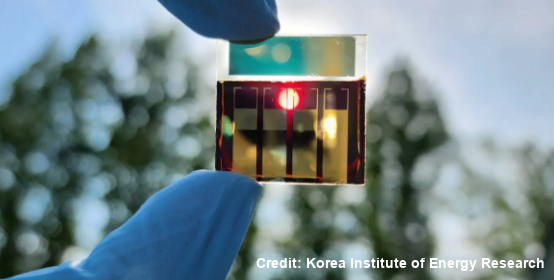
Solar cells are incredible. Despite advances in renewable power, solar panels remain one of the most viable ways for homes, businesses, and other small-scale enterprises to generate their own electricity. There's just one problem: Solar panels are bulky and need to be oriented in a very specific way in order to be worth the cost and effort of installing them. Some buildings may not have the right lighting conditions, or simply don't have a large enough footprint to justify outfitting them with their own solar panels. Fortunately, semi-transparent solar cells are a new type of photovoltaic cell that could be suitable for a much wider variety of situations.
A semi-transparent solar cell is a solar cell that allows some light to pass through. Where old-school conventional solar cells convert some light into energy and reflect the rest, a semi-transparent solar cell allows some visible light through. Think of it like a tinted window that also generates electricity.
Semi-transparent solar cells are made up of an extremely thin layer of semiconductor material placed between two thin sheets of glass. This semiconductor material can be one of many: perovskites, chalcopyrite, cadmium-telluride, amorphous silicon, or even organic materials, to name a few.
Like conventional solar cells, light strikes the semi-transparent solar cell. Light in the ultraviolet spectrum is converted to electricity, while some of the remaining visible light passes through the glass. This means that it can be layered over windows to produce power while still allowing occupants to see outside and receive natural sunlight.
On one end of the spectrum, you have conventional solar cells. On the other, there are fully transparent cells. How well do semi-transparent solar cells stack up?
1. They tolerate heat a lot better than some fully transparent cells do.
While the technology for fully transparent solar cells exists, it still has some kinks to work out. The biggest one among them is longevity. Since conventional semiconductor material is opaque, researchers seeking to make transparent panels have had to turn to some unique alternatives. Some of these are organic molecules, which tend to degrade over time—especially when exposed to heat.
Semi-transparent cells can use a wider variety of semiconductor materials since they don't need to be fully transparent. This includes materials that don't degrade as easily, so they maintain their efficiency and keep working longer.
2. They don't lose as much efficiency when they're at a less-than-optimal angle.
The light-to-power conversion efficiency of solar panels tends to drop off pretty sharply when they're oriented at a less than perfect angle. Semi-transparent solar cells are no exception, but they don't lose nearly as much efficiency as conventional panels do. This means that they still work decently well when installed vertically, like over windows or glass building facades.
3. They cost less than fully transparent cells.
A window made of fully transparent solar cells can be pretty pricey—to the tune of over $400 per square meter. By contrast, a square meter of semi-transparent solar cells starts at about $80. That's roughly the same cost as a regular double-pane glass window, with the added benefit of power generation.
4. They're more versatile than conventional solar cells.
Conventional solar cells need to be oriented at a certain angle, facing the direction of optimal sun exposure. Fully transparent solar cells can cover windows and building facades, but struggle with high heat. Semi-transparent solar cells, on the other hand, can be incorporated into windows and hung vertically, and they have better longevity than transparent cells.
5. They help keep buildings cool.
If you've ever had to sit in front of a southern-facing window in the middle of the day, you know how hot it can get. Semi-transparent solar cells can take that light and not only turn it into electricity, but also let in just enough to illuminate the room's interior while keeping the worst of the heat at bay. Since they don't let in as much light as a fully transparent solar cell or regular window, they can help building interiors stay cooler when it matters the most.
While semi-transparent solar cells do have some trade-offs when it comes to efficiency (up to 10%, versus about 25% for conventional solar cells), this is made up for by their advantages. They maintain their efficiency and work in a broader range of applications than regular solar cells, and last longer and cost less than fully transparent cells.